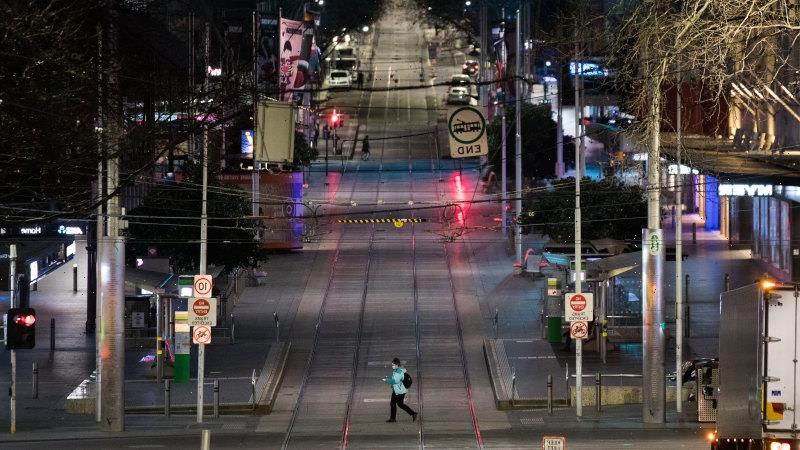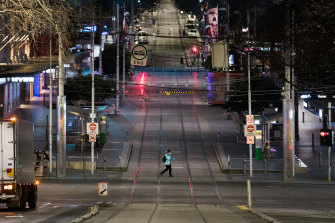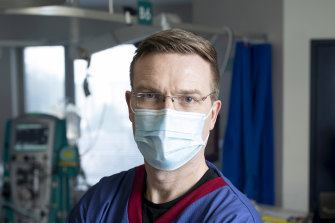For our free coronavirus pandemic coverage, learn more here.
There have been plenty of big news days in Victoria over the last 18 months. This week could have seen the most significant of them all.
After more than 210 days of lockdown for Melbourne, and longer in some hotspot suburbs, Premier Daniel Andrews declared on Wednesday that the dream of “COVID Zero” was over. It’s unlikely that coronavirus case numbers can be brought down, at least for the short term.
A quiet Bourke Street during Melbourne’s sixth lockdown.Credit:Jason South
The focus will now shift to slowing the spread of the infectious Delta strain as we race to get vaccinations to a level that will avoid our hospitals being overwhelmed.
Whatever your views on the restrictions we have faced, this news could have left you feeling like the sacrifices we’ve made since March last year have been for nothing. And the sacrifices have been considerable. Everyone has a story, everyone has felt the toll, and most of us know plenty who have had it worse.
But it has not been a waste. Our collective efforts have saved many thousands of lives; and those Australians living in relative freedom in other states can partly thank Victorians for that.
Modelling recently conducted by the Burnet Institute found that lockdown six has already prevented more than 6000 local COVID cases in this latest outbreak.
But the scenario that we avoided in 2020, before any vaccines had arrived, remains our greatest achievement to date. While about 800 people died in Victoria’s second wave, you only need to look at places like Britain and the US to realise it could have been far worse.
If we’d seen deaths at a similar rate to those experienced in Britain in Victoria, there could have been roughly 15,000 socially distanced funerals.
Stephen Warrillow, the director of intensive care at Melbourne’s Austin Hospital said while he’d love to say hard-working doctors and nurses had saved the day, the real credit lay with the community at large.
If Victoria hadn’t endured its longest lockdown, more people would have died preventable deaths, of COVID but also of other things.
Dr Stephen Warrillow says hospitals and ICUs in Melbourne are gearing up for new cases.Credit:Arsineh Houspian
“I guess it’s easy to forget what happened in northern Italy, the United Kingdom and the United States,” said Associate Professor Warrillow.
“We would have our own particular version of the situation here in Victoria. Intensive care would have absolutely been full of COVID and we would have struggled to manage anything else.”
Crucially (and this is perhaps the main point) Melbourne’s 110-plus days in lockdown in 2020 also bought Victoria and the rest of the country valuable time for vaccination.
This is probably best illustrated by NSW’s second wave, which is now much larger than Victoria’s 2020 outbreak, but has seen far fewer deaths because by the time it took hold a large proportion of the older population had received at least one vaccination dose.
About 1 in 220 people diagnosed with COVID in NSW since June have died, well below the usual death rate from the disease. Compare that to Victoria last year, when by the end of the second wave about 1 in 25 people had died. The virus hasn’t got any less deadly, we’ve just had time to largely ring-fence our nursing homes with vaccinations.
In recent months, there has been an emerging narrative that we just need to get on with “living with COVID”. But here’s a reality check. Even as NSW might be held up as the way forward, it’s clear those in Sydney and many other NSW communities aren’t doing much living in the way the term is intended. They are in lockdown with the virus. Hospitals are stretched. The “middle ground” scenario is a furphy, for now.
James Trauer, the head of the epidemiological modelling unit at Monash University, doesn’t believe there is a country in the world that’s been able to live safely alongside the Delta strain of coronavirus without a very high level of vaccinations.
He pointed to Vietnam which had previously been hailed as a COVID success story, but is now reporting hundreds of deaths a day with just a fraction of the population fully vaccinated.
This week Melbourne’s intensive care units have been dusting off their surge plans and reconfiguring spaces to make room for new COVID patients. Like all of us, the staff are exhausted.
But, again, they will be relying on the Victorian community. They need us all to get vaccinated. Unfortunately, they also need us to stay in lockdown for a little longer.
As epidemiologist James McCaw explained a few weeks ago, shooting for “COVID Zero” and trying to reduce coronavirus case numbers look pretty much the same.
Associate Professor Trauer said he doesn’t expect non-essential stores, cafes and bars to reopen until next month.
The Premier has insisted that some restrictions will have to remain until 70 per cent of the adult population is fully vaccinated, to prevent rising cases overwhelming the hospital system. That level of vaccination is expected to be reached in late October.
By then many of us will be carrying pandemic scars that may never heal. We should also know our sacrifices haven’t been in vain.
We’ve saved thousands of lives. We’ve made it safer for other states to enjoy freedoms and better economies.
We bought time for the entire nation to vaccinate the most vulnerable and make a good start on the rest. There are people alive today that wouldn’t have been, if it wasn’t for the actions of us all.
So thank you Victoria, for everything.
Stay across the most crucial developments related to the pandemic with the Coronavirus Update. Sign up for the weekly newsletter.
Most Viewed in National
From our partners
Source: Read Full Article







